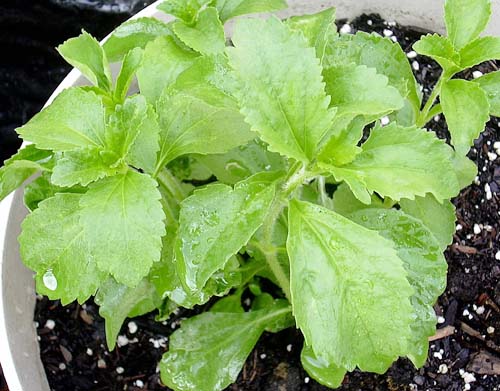Dr. Vikas Gupta
Stevia rebaudiana (Bert.) is a herbaceous perennial plant of the Asteraceae family. The leaf extract of this plant has been used traditionally in the treatment of diabetes. Stevia rebaudiana is an important medicinal crop grown in India for its leaves containing a non-calorific sweetener and stevioside. It is the only natural sweetener available in the market. It is used for sweetening for centuries in Paraguay and has been in use since last 400 years across the world. It is the only sweetener which does not have any side effect. It reduces the calories from your food which makes it a suitable replacement of sugar for calorie conscious as well diabetic people. It is also being found by people that the regular use of stevia helps in reactivating the insulin secreting cells in pancreas.
The raw stevia leaves are around 35-40 times sweeter than sugar, stevia extract are sweet upto 300 times of ordinary sugar. The stevia is safest low calorie sweetner. Stevia and stevia powder extract are marketed in many countries across the globes. Stevia is also useful in lowering blood sugar and it reduces the tooth cavity hence it can be used in tooth pastes in place of sugar to avoid tooth decay. A wet Stevia leaf bag provides a cooling effect on eyes (similar to using cucumber). The leaves effectively tighten the skin and are good for wrinkles.
Stevia has proved to give exceptional benefits when used regularly in skin care. It also has a healing effect on blemishes, wounds, cuts and scratches. Stevia is helpful in weight and blood pressure management. It has also been reported that stevia lowers incident of colds and flu. Stevia leaf powder can be used as a face pack with rose water as it possesses great anti wrinkle qualities in it. Dried powdered leaves use in tea as well as in recipes such as jam, choco, bavarois etc., and of fresh leaves in salads and in sweet vinegar. This is used as an alternative to artificially produced sweeteners. In addition, the sweet steviol glycosides have functional and sensory properties superior to those of many other high potency sweeteners and is likely to become a major source of high potency sweetener for the growing natural food market in the future.
It is a small perennial shrub plant growing up to 65 cm, with sessile, oppositely arranged lanceolate to oblancoelate leaves, serrated above the middle. Trichome structures on the leaf surface are of two distinct sizes, one large (4-5 µm) and the other small (2.5 µm). It has small flowers (7-15 mm) of white colour arranged in an irregular cyme. The seed is an achene with a feathery pappus. Stevia plants can be propagated from cuttings or through seeds. Seed germination rate is poor and seedling establishment is very slow in this case. It is best grown as an annual or perennial transplanted crop. India being largest consumer of cane sugar along with largest diabetic population in the world, Stevia is ideally poised to make significant contribution in satisfying the Indian demand of natural low calories sweetener.



